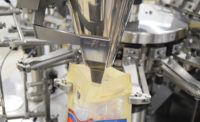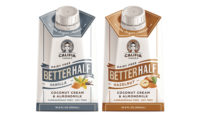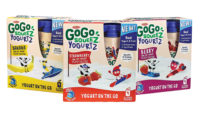A survey of the dairy department shows an array of devices that secure the product against the casual sampler or the criminal tamperer. Options include tear strips, shrink bands/labels, sealed lidstock and breakaway devices on closures. Many tamper-evident designs also enhance freshness or prevent leakage.
Italy’s Sammontana Ice Cream relies on a tamper-evident lidstock from Cellografica Gerosa to seal polypropylene containers of ice cream. A peelable sealing layer and diecut tab aid the removal of the film, which is a laminate of reverse-printed biaxially oriented polyethylene terephthalate (PET)/Appeel adhesive resin. The Appeel adhesive resin from DuPont simplifies inventory requirements because it seals to PET, polystyrene and polyvinyl chloride cups and trays as well as to polypropylene. A broad temperature sealing window and excellent hot-tack maximize productivity on the packaging line. Good organoleptics mean the solvent-free lidstock doesn’t impart any off-taste or odor to the ice cream.
Another tamper-evident design for ice cream packages is the SecurTec 100 composite lid from Stanpac, which eliminates the need for neck bands or lidstock. Spin rod or elevator lidding equipment applies the printed 16-point poly-coated paperboard/linear-low-density polyethylene lid to 14-ounce, pint or 500-milliliter paperboard ice cream cups. Brand owners may specify a stock or custom color for the skirt, which features a grab-and-pull TE strip. Approximately 20 dairies have adopted the design, including organic processor Three Twins Ice Cream, Petaluma, Calif.
Counterfeit protection
Although the dairy industry might not experience as many cases of counterfeiting as pharmaceuticals or apparel, brand protection can be a concern, especially for premium products. Fortunately, there are covert and overt tools available to authenticate product and discourage counterfeiters. Some techniques carry an upcharge while others are virtually free.
Overt elements include holograms, color-shifting security inks and guilloche patterns. A holographic security label from New Zealand-basedAsuraseal Ltd. combines tamper evidence with up to nine customizable optical anticounterfeiting features. Stock size measures 20 x 10 millimeters (approximately 0.78 x 0.39 inches). The holographic material fuses to virtually any flexible packaging material, including those with an ultraviolet varnish. A hot-stamp or rolling process applies the holographic label in the seal area. A QR code can be included to give shoppers point-of-sale verification when they scan the code with a SmartPhone.
Covert authentication elements are invisible to the naked eye and often require a magnification or a proprietary decoding device to be “seen.” However, a growing number of covert technologies authenticate via a SmartPhone scan, reducing costs and allowing virtually anyone to verify product authenticity.
Common covert authentication options include micro-printing, voiding effects that reveal a message when removed and printing with inks that are visible only under ultraviolet or infrared light.
For brand owners with continuous inkjet coders, OnCode, a division of Gem Gravure, mixes custom or standard DNA Matrix security markers from DNA Technologies into the ink used to print visible or invisible codes. A camera reads the DNA strands in the ink to authenticate the product.
Serialization, the assignment of a unique code at the unit level, not only can be used to authenticate product, but also to track it through the supply chain. This traceability (or pedigree) data can be particularly helpful in pinpointing and locating affected product in recall situations.
A push from FSMA
Implementation of the Food Safety Modernization Act (FSMA) is prompting review of food safety and risk assessment practices. As a result, interest in food safety certification is growing among brand owners and food packaging suppliers. In fact some brand owners are likely to require their food packaging suppliers to be certified as a condition of doing business. Supplier certification not only helps dairy product producers comply with FSMA, but also gives them confidence that production of food-contact materials conforms to appropriate quality assurance and risk management protocols.
Find more packaging suppliers in the Dairy FoodsBuyers Guide. Go to buyersguide.dairyfoods.com/buyersguide.



